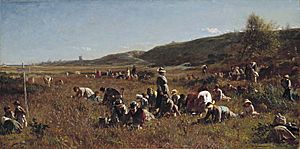Cranberry facts for kids
Quick facts for kids Cranberry |
|
|---|---|
 |
|
| Cranberry bush with fruit partially submerged | |
| Scientific classification | |
| Kingdom: | |
| (unranked): | |
| (unranked): | |
| (unranked): | |
| Order: | |
| Family: | |
| Genus: | |
| Subgenus: |
Oxycoccus
|
| Species | |
|
Vaccinium erythrocarpum |
|
A cranberry is a small, round, red fruit. It grows on low-lying green plants that stay green all year. These plants are a type of dwarf shrub. Cranberries belong to the Vaccinium plant family.
Cranberry plants grow best in wet, acidic areas called bogs. You can find them in cooler parts of the northern hemisphere. The plants are low to the ground, usually only a few inches high. They have thin stems and small, evergreen leaves. Their flowers are a pretty dark pink. People often eat cranberries during Thanksgiving in the United States. They are also popular in Europe and some parts of South America.
Cranberries are a big farm crop in certain American states and Canadian provinces. Most cranberries are made into products like juice, sauce, jam, and sweetened dried cranberries. Some are sold fresh. Cranberry sauce is a common side dish with turkey for Christmas dinner in the United Kingdom. It's also a tradition for Christmas and Thanksgiving dinners in the United States and Canada.
Contents
Discovering Cranberries and Their Name
The name "cranberry" comes from "craneberry." Early European settlers in America gave them this name. They thought the cranberry flower looked like the head and neck of a crane. In some parts of northeastern Canada, they are called "mossberry." In the 1600s, people in New England sometimes called them "bearberries." This was because bears were often seen eating them.
In North America, Native Americans were the first to use cranberries as food. They used them in many dishes, like pemmican. Cranberries were also used for medicine to treat wounds and as a dye. Some historians believe Algonquian peoples shared cranberries with early English settlers in Massachusetts. These berries then became part of the traditional Thanksgiving feasts.
An American Revolutionary War veteran named Henry Hall was the first to farm cranberries. He started growing them in Dennis, Massachusetts, around 1816. By the 1820s, cranberries were being shipped all the way to Europe.
How Cranberries Are Grown
Cranberries used to be grown in natural wetlands. Today, farmers build special cranberry beds in higher areas. These areas have water close to the surface of the ground. Farmers first remove the topsoil. Then, they build small walls called dykes around the edges of the bed. Clean sand is brought in and spread out. It forms a layer about four to eight inches deep. The surface is made perfectly flat. This helps the water drain evenly. Special equipment is also installed to water the plants. This irrigation also protects the plants from frost in spring and autumn.
The Fraser River Valley in British Columbia, Canada, grows a lot of cranberries. They produce about 17 million kilograms of cranberries each year. This is about 95% of all Canadian production. In the United States, Wisconsin is the top cranberry producer. It grows more than half of all U.S. cranberries. Massachusetts is the second biggest U.S. producer. Some cranberries are also grown in southern Argentina, Chile, and the Netherlands.
Delicious Ways to Use Cranberries
Fresh cranberries are quite hard and have a tart, bitter taste. Because of this, about 95% of cranberries are processed. They are used to make cranberry juice and sauce. You can also buy them dried and sweetened.
Cranberry juice is usually sweetened or mixed with other fruit juices. This helps to reduce its natural tartness. Many drinks, like the Cosmopolitan, are made with cranberry juice.
Often, fresh cranberries are cooked into a compote or jelly. This is known as cranberry sauce. Cranberry sauce is traditionally served with roast turkey. It's a key part of English Christmas dinners. It's also a must-have for Thanksgiving in both Canada and the United States. Cranberries are also used in baking. You can find them in muffins, scones, cakes, and breads. In baking, they are often paired with orange or orange zest. Sometimes, cranberries are added to savory dishes like soups and stews. They give these dishes a nice tart flavor.
You can freeze fresh cranberries at home. They will stay good for up to nine months. You can use them directly in recipes without needing to thaw them first.
Images for kids
-
Cranberry harvest in New Jersey
-
Arthur Rothstein, Child Labor, Cranberry Bog, 1939. Brooklyn Museum
See also
 In Spanish: Arándano rojo para niños
In Spanish: Arándano rojo para niños











